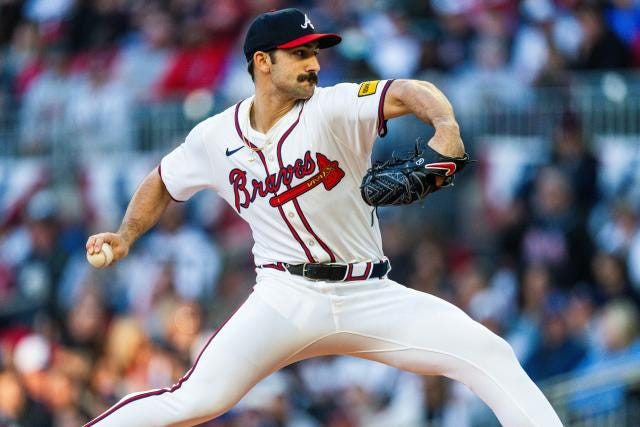The UCL "Epidemic" Part 1: Absolute's View
Are Those That Injure Their UCL's Being Naturally Selected by Baseball?

The first half of the 2024 Major League Baseball season have shone a spotlight again on arm injuries, specifically of the ulnar collateral ligament of the elbow. In fact, the potential comeback story of the year has been stopped as a result of an MRI-confirmed UCL tear for Alex Manoah of the Toronto Blue Jays. He had his UCL reconstructed on June 17th by Dr. Keith Meister.
In the past, as part of FRS, I have worked with numerous MLB organizations and have had the opportunity to discuss this particular injury with many of their staff members, both from a mitigation perspective and a performance perspective. These discussions have been fulfilling and have generated a lot of insight on my behalf. Yet, there still seems to be no traction on how best to deal with the very real possibility that any organization’s top arm(s) may undergo an injury this significant.
Absolute’s Views on UCL Injuries
At Absolute, we have considered this newly resurfaced pitching “epidemic” from a couple of viewpoints:
This is not a new issue. Many in the game continue to blame the same external factors as being causative of potential throwing-related UCL injuries. As a matter of fact, this dialogue has increased over the last year as a result of the introduction of the pitch clock into MLB. So now, on top of pitch velocity, pitch spin rate and mechanics (amongst others) there are game constraints, such as the pitch clock being discussed as the reason why injury rates are so high.
Consider this from an ecological perspective. For over 15 years, those within the sport, as well as those who write on the sport, have harped on all the factors that exist at the Level of Competition. Factors that exist within this ecological niche exist outside of the system (athlete) and are observable behaviours produced by the system during its performance. The new gameplay constraints are part of this niche, whereby they are just boundary conditions at this level as to the width of the tracks that the athlete can manoeuvre on.
From this point of view we can establish there are now rules that govern the system as it attempts to function optimally at this level. We know that:
There must be a minimum velocity output (mid-90s) to be considered roster-worthy in MLB.
Going with this new era of tech and analytics, pitch spin rates are analyzed, pitchers now have data that shows that there needs to be a correlative spin rate per pitch that is ideal for that pitch to be successful.
Athletes must perform these things within an environment that is slightly more limited on time between pitches.
The athlete must be considered. Where there has not been effective discussion concerning arm (elbow) injuries is with respect to the athletes themselves. Sure, there are many strength practitioners who work with baseball athletes that can show high-level programming, but in reality, for an athlete who throws a ball with the performance specifications of an elite pitcher, these programs are no different than any other athlete and often fail to satisfy the demand requirements of these athletes—get them to Point B. This has a significant impact as The Level of Adaptation is an extremely important consideration as it is the ecological niche within which strength and performance behaviours are cultivated that allow for the meeting of demand and capacity. Having pitchers lift heavy and do sport-specific training, with little to no tissue-specific training for the arm, shows that most are satisfied with how we have produced our athletes to withstand the rigours mentioned above and will direct the “blame” for these injuries elsewhere.
Developmentally, has the sport of baseball done this to themselves? It is interesting to consider that the sport, and those involved in developing players that may become future professionals have created a system whereby it has the necessary components that drives undesired outcomes. To this end, we are referring to elite travel teams, early recruitment of athletes, and the existence of organizations that cater to higher talent level players and lure them to early specialization. This early specialization, by having young athletes perform like grown professionals, leads to not only obvious factors such as fatigue and burnout but a wealth of other internal factors that create overload and a potential inability to maintain longevity. All systems function, but not all systems function efficiently and effectively in creating necessary behaviours. Without going into the specifics of youth development and the culture of travel baseball (another discussion more aptly had with those involved), a valid hypothetical argument can be made that the hyper-intense focus of high-level baseball early in an athlete's life sets them up for system behaviours later in life that are highly undesirable.
Has The Sport of Baseball Done This To Themselves? We Think So
At Absolute, we believe that all of the above have intertwined to become determinants of a very widespread issue. Specifically, we think point #3—whether the sport of baseball has done this to itself—deserves deeper discussion, as no one has addressed this point at this time.
In Part 2, we will start to articulate and explore all the facets that we feel relate to baseball doing this to itself. From an ecological point of view, it becomes apparent that those pitchers that break down and suffer from catastrophic throwing related elbow injuries are lacking resources within some component of the biological ecosystem. We will use evidence on the topic of early tissue senescence and its potential effects as the basis of our argument.





This is great. Seeing concepts taught in the seminars manifest in real life at the professional level is a great way to synthesize the information. Appreciate the post guys!